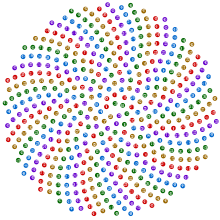I don't watch too much tv, so I think, but I must say: I am really looking forward to watching this show!! I get so excited by numbers, patterns, codes, etc. I think about how much other generations were able to accomplish because they had/made time to figure things out. If we can take 1% of the population and raise them to be curious, I believe so many amazing things could be deciphered. Anyway, check out the clip. Kiefer Sutherland also did the series 24. This one is about the Fibanacci code.
How it relates to nature, according to wikipedia today: http://en.wikipedia.org/wiki/Fibonacci_number
--------------------------------------------------------------------------------------------
In nature
Yellow Chamomile head showing the arrangement in 21 (blue) and 13 (aqua) spirals. Such arrangements involving consecutive Fibonacci numbers appear in a wide variety of plants.
Przemysław Prusinkiewicz advanced the idea that real instances can in part be understood as the expression of certain algebraic constraints on free groups, specifically as certain Lindenmayer grammars.[51]
A model for the pattern of florets in the head of a sunflower was proposed by H. Vogel in 1979.[52] This has the form
[edit] The bee ancestry code
Fibonacci numbers also appear in the description of the reproduction of a population of idealized honeybees, according to the following rules:- If an egg is laid by an unmated female, it hatches a male or drone bee.
- If, however, an egg was fertilized by a male, it hatches a female.
If one traces the ancestry of any male bee (1 bee), he has 1 parent (1 bee), 2 grandparents, 3 great-grandparents, 5 great-great-grandparents, and so on. This sequence of numbers of parents is the Fibonacci sequence. The number of ancestors at each level, Fn, is the number of female ancestors, which is Fn−1, plus the number of male ancestors, which is Fn−2.[54] (This is under the unrealistic assumption that the ancestors at each level are otherwise unrelated.)
--------------------------------------------------------------------------------------------
Loving it! I don't assume that my children will love math, patterns, numbers, and solving problems to the same degree as me, but I think it would be neat if they grow to appreciate its beauty in the universe. :-)


No comments:
Post a Comment